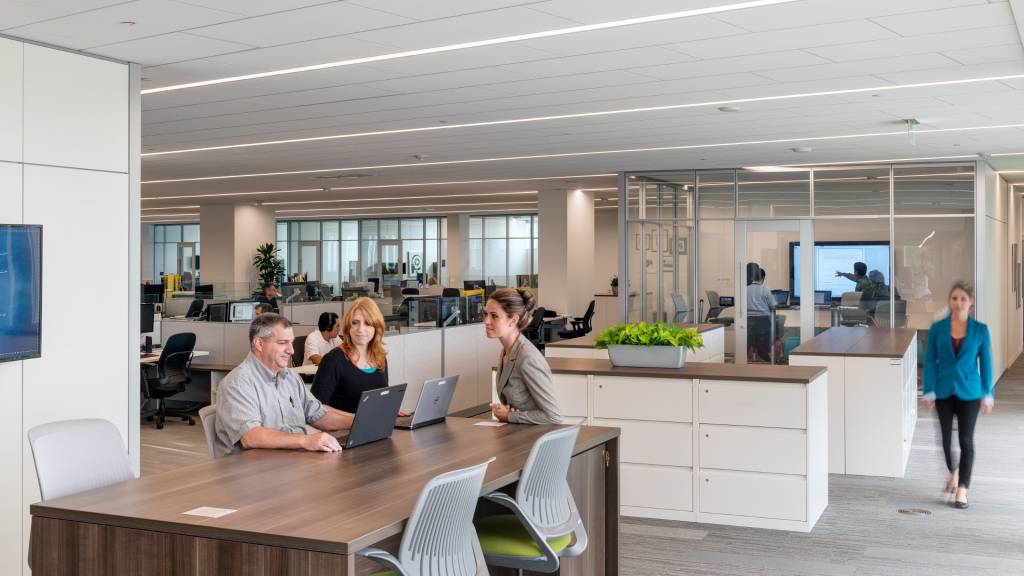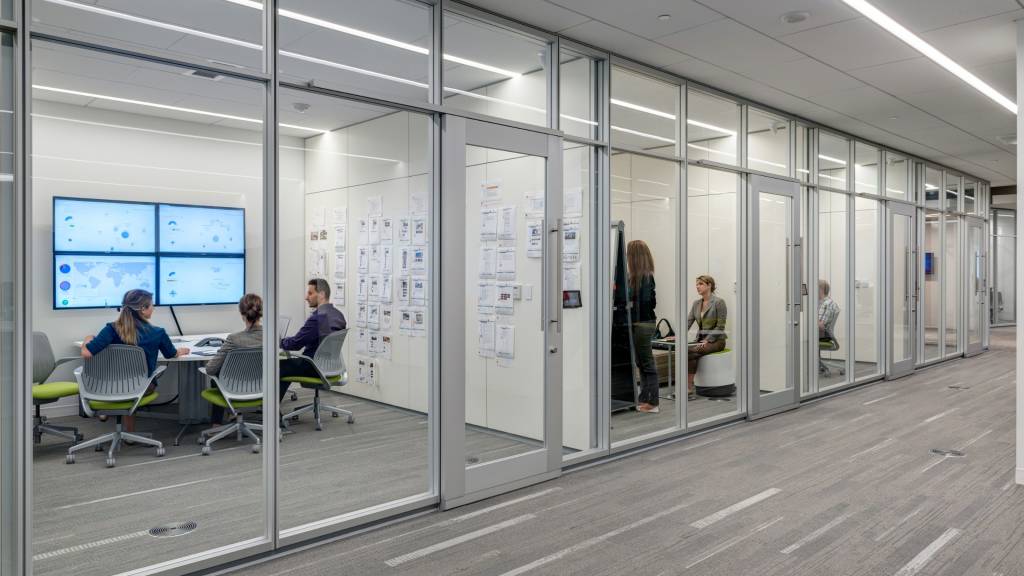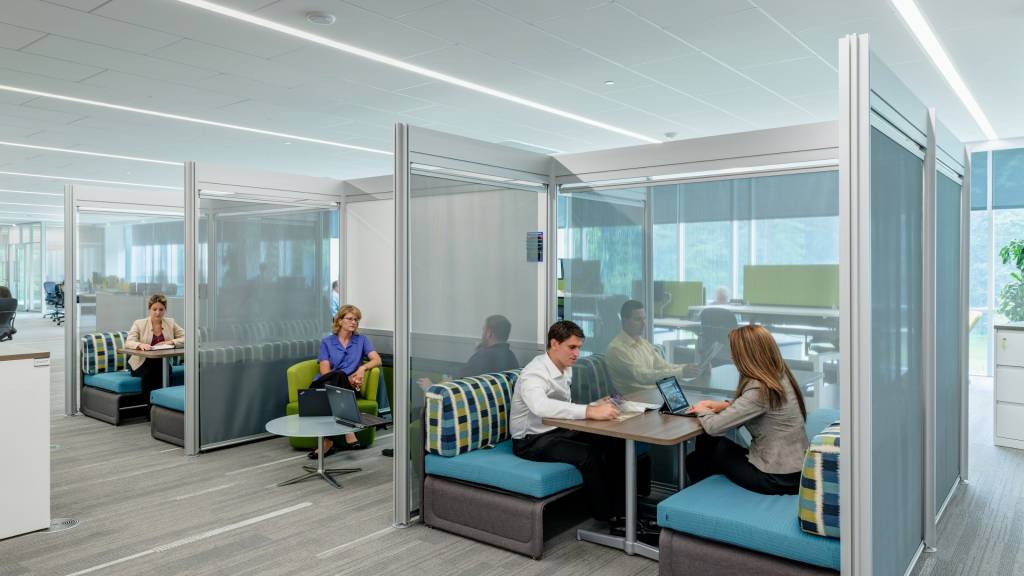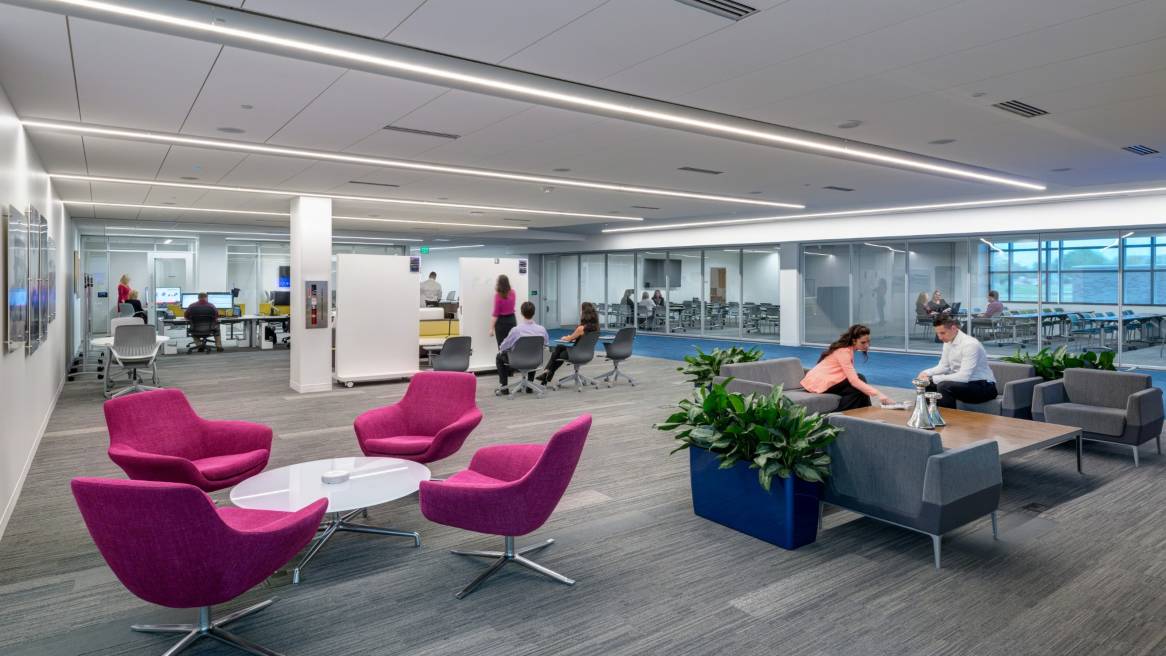La-Z-Boy Reflects Culture in New Office
Creating a New Company From the Inside Out
When you’re almost a hundred years old, being a little dated is to be expected. The 1920’s vintage headquarters of La-Z-Boy, however, didn’t just look out of date, it was holding the company back.
Cubicles and walls stifled communication and collaboration. Employees assigned to fixed desks and technology couldn’t easily share information and ideas. Piecemeal office renovations over the years did little to support changing work processes or bolster organizational culture. Potential recruits, existing customers and dealers all disliked coming to La-Z-Boy’s headquarters.
“We were working in the dark ages,” says Kurt Darrow, chairman, president and CEO.
Once La-Z-Boy decided to build a new office building, the story could have been an impressive one on its own: how the company transformed its headquarter’s real estate from a liability into a high performing asset. (See Part I of the “La-Z-Boy” case studies.)
La-Z-Boy leadership, however, decided to up the stakes. “A new workplace offers an opportunity to change the culture, to do things differently as an organization. That became a strategy for us, to use this new space to create change throughout our company,” says Darrow.
The building as a tool to change the culture
“We thought about it this way: If we started with a clean sheet of paper, what things would you change? What things would you eliminate? What things can we do better? The building was a catalyst that got us thinking about how we wanted to work, what kind of culture we wanted for ‘the new La-Z-Boy.'”
Leadership addressed a growing concern in many companies around the world. Studies show that organizational culture and employee engagement are among the most pressing issues for corporate leaders. In fact, 87 percent of organizations cite them as one of their top challenges.[1]
The work environment has a major impact on those issues, but is often overlooked by many organizations. La-Z-Boy would use their new corporate headquarters building, and an extensive culture change management program developed with Steelcase Applied Research & Consulting, to help transform the organization’s culture and re-energize employees.
But first, it needed to clearly define where the company was headed.
Setting the bar high
La-Z-Boy’s objectives were derived from the company’s Critical Success Factors — the few, crucial things a company must do well to achieve their goals over the next three to five years.
“Each organization is different. Leadership has to determine how much change the organization needs and how much it can handle. La-Z-Boy leadership set the bar high, with major changes in their people, space, culture, processes and technology. Each would be redefined or transformed. That’s significant for any organization,” says Jeff Block, principal of the ARC group and consultant to
La-Z-Boy.
La-Z-Boy’s Critical Success Factors, developed by leadership with assistance from ARC, included:
- fostering more open and trusting communication across the organization
- attracting new employees and developing current ones
- increasing connections between individuals in different groups to build trust and increase knowledge transfer
- demonstrating leadership support for a flexible and mobile workplace
making people responsible, empowered and accountable - retaining the heritage and key cultural attributes of the company
These factors helped define the organizational culture the company desired, and in turn informed the work environment. For example, helping employees be more empowered and accountable led to providing them with laptops and an ecosystem of workspaces, so employees (with no assigned workspaces) can choose each day where and how they need to work.
The change would require more than laptops and fast Wi-Fi. Training for both management and staff were needed, and, more importantly, a major effort to engage with employees to drive change in company culture.

Building employee ownership
To help plan and implement the changes, the ARC team assessed existing work processes and workspaces, and led workshops with staff and management to gather input and ideas to inform the design of the new workplace. They also developed tools to help management promote culture change.
Employee involvement was key. “ARC interviewed all of our people here at the home office. They asked them what they needed in the new office, how they worked, and observed how they went about their business,” says Darrow.
“From the focus groups, to the pilot, to move in, employees were engaged throughout the process,” says Sue Vanisacker, director of community relations and talent acquisition.
La-Z-Boy executives lead critical focus groups. Mark Bacon, president of the company’s branded business, held monthly breakfast meetings with employees (“Bacon with Bacon”) “to help us understand what we do right in terms of work processes and what we could do better. Common themes developed, and that was one way our employees helped build this building.”
Leader workshops developed the critical success factors and assessed the organization’s readiness for change. Staff workshops considered how the critical success factors could be best supported by the work environment. All workshop groups built three-dimensional models to demonstrate desired workplace concepts.
The results from the workshops informed the design of the work environment, and took the change management program to a critical stage: the workplace piloting program. A major investment, its success would depend on getting employees to use the pilot space and provide thoughtful feedback.

Workplace piloting
Unlike a typical mock-up, a piloting program is longer term and gets users more involved. “A mock-up is like seeing a car in the showroom, but not driving it for any length of time. You can’t envision the future in a quick mock-up because you’re experiencing a new concept in the context of what you know,” says Block. “Employees need time to try out new spaces, test workspace concepts and provide good feedback.”
At 10,000 square feet, with space for 125 people to work for 90 days, the piloting program required a substantial investment.
“It allowed people to work in the environment for weeks, to get a feel for the new spaces, what to expect in the new building,” says Bacon. He emphasizes that it helped staff take ownership of the new space. “It was a great investment in our culture and our future.”
“The pilot program was a great investment in our culture and our future.”
Mark BaconPresident of La-Z-Boy’s Branded Business
The building sends a signal: things are changing
Throughout the headquarters project, internal communication was constant: in-person meetings, emails, videos (one favorite: a weekly video of the building construction, shot with a drone developed by the IT group), and four visits for all employees to the new site at different stage of development.
Change management efforts continued after the move, often in tandem with other corporate efforts. For example, a building scavenger hunt encouraged employees to visit the various workspaces in the building, an activity that dovetailed with the company’s wellness efforts.
“You couldn’t sit in the old office and tell employees things were changing. This new space is a very visible, tangible icon of change. It sends a signal: things are changing, and no one’s surprised that we’re changing as a company,” says Eric Hulseman, project manager.
“When I first heard about culture change management, I thought it was a fluffy, light-weight kind of thing. Now, having gone through it, I think it one of the most important things we’ve done.”
“The culture change management program was one of the most important things we’ve done.”
Eric HulsemanProject Manager
Employees at other La-Z-Boy locations were also involved in the culture change effort. All employees were surveyed and are providing input on changes to their own work environments. “We’re replicating the process at our plants, our showrooms, and our R&D center,” says Vanisacker.

La-Z-Boy’s new headquarters is the physical expression and a key driver of the company’s internal transformation. It supports and encourages a more open and transparent organization, with greater communication and more frequent collaboration —a key objective for the transformed organization.
“The new La-Z-Boy” is emerging, says Darrow, proud of the team. “Change is hard enough for any organization. We pushed as much change on them as they could handle —and they’ve adapted marvelously.”
He credits Steelcase Applied Research & Consulting as important partners in the project. “You know, we’ve built factories, and we’ve built stores, but we’ve never done anything like this.
“I was blown away with what ARC did for us. We could have missed quite an opportunity without them guiding us. What they’ve added has been invaluable.”
[1] Global Human Capital Trends 2015, Deloitte University Press
CREDITS
Architecture and Design: The Collaborative
Dealership: NBS Commercial Interiors
Culture Change Consulting: Steelcase Applied Research & Consulting


